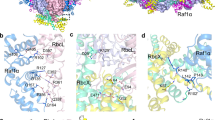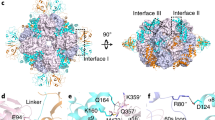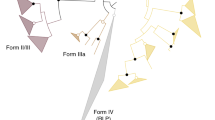Abstract
Ribulose-1,5-bisphosphate carboxylase/oxygenase (Rubisco) catalyzes the fixation of CO2 in photosynthesis. Despite its pivotal role, Rubisco is an inefficient enzyme and thus is a key target for directed evolution. Rubisco biogenesis depends on auxiliary factors, including the GroEL/ES-type chaperonin for folding and the chaperone RbcX for assembly. Here we performed directed evolution of cyanobacterial form I Rubisco using a Rubisco-dependent Escherichia coli strain. Overexpression of GroEL/ES enhanced Rubisco solubility and tended to expand the range of permissible mutations. In contrast, the specific assembly chaperone RbcX had a negative effect on evolvability by preventing a subset of mutants from forming holoenzyme. Mutation F140I in the large Rubisco subunit, isolated in the absence of RbcX, increased carboxylation efficiency approximately threefold without reducing CO2 specificity. The F140I mutant resulted in a ∼55% improved photosynthesis rate in Synechocystis PCC6803. The requirement of specific biogenesis factors downstream of chaperonin may have retarded the natural evolution of Rubisco.
This is a preview of subscription content, access via your institution
Access options
Subscribe to this journal
Receive 12 print issues and online access
$259.00 per year
only $21.58 per issue
Buy this article
- Purchase on Springer Link
- Instant access to full article PDF
Prices may be subject to local taxes which are calculated during checkout






Similar content being viewed by others
Accession codes
References
Whitney, S.M., Houtz, R.L. & Alonso, H. Advancing our understanding and capacity to engineer nature's CO2-sequestering enzyme, Rubisco. Plant Physiol. 155, 27–35 (2011).
Hohmann-Marriott, M.F. & Blankenship, R.E. Evolution of photosynthesis. Annu. Rev. Plant Biol. 62, 515–548 (2011).
Andersson, I. & Taylor, T.C. Structural framework for catalysis and regulation in ribulose-1,5-bisphosphate carboxylase/oxygenase. Arch. Biochem. Biophys. 414, 130–140 (2003).
John Andrews, T. & Whitney, S.M. Manipulating ribulose bisphosphate carboxylase/oxygenase in the chloroplasts of higher plants. Arch. Biochem. Biophys. 414, 159–169 (2003).
Barraclough, R. & Ellis, R.J. Protein synthesis in chloroplasts. IX. Assembly of newly-synthesized large subunits into ribulose bisphosphate carboxylase in isolated intact pea chloroplasts. Biochim. Biophys. Acta 608, 19–31 (1980).
Goloubinoff, P., Christeller, J.T., Gatenby, A.A. & Lorimer, G.H. Reconstitution of active dimeric ribulose bisphosphate carboxylase from an unfolded state depends on 2 chaperonin proteins and Mg-ATP. Nature 342, 884–889 (1989).
Goloubinoff, P., Gatenby, A.A. & Lorimer, G.H. GroE heat-shock proteins promote assembly of foreign prokaryotic ribulose bisphosphate carboxylase oligomers in Escherichia coli. Nature 337, 44–47 (1989).
Brinker, A. et al. Dual function of protein confinement in chaperonin-assisted protein folding. Cell 107, 223–233 (2001).
Saschenbrecker, S. et al. Structure and function of RbcX, an assembly chaperone for hexadecameric Rubisco. Cell 129, 1189–1200 (2007).
Liu, C. et al. Coupled chaperone action in folding and assembly of hexadecameric Rubisco. Nature 463, 197–202 (2010).
Kerner, M.J. et al. Proteome-wide analysis of chaperonin-dependent protein folding in Escherichia coli. Cell 122, 209–220 (2005).
Tsai, Y.-C.C., Mueller-Cajar, O., Saschenbrecker, S., Hartl, F.U. & Hayer-Hartl, M. Chaperonin cofactors, Cpn10 and Cpn20, of green algae and plants function as hetero-oligomeric ring complexes. J. Biol. Chem. 287, 20471–20481 (2012).
Onizuka, T. et al. The rbcX gene product promotes the production and assembly of ribulose-1,5-bisphosphate carboxylase/oxygenase of Synechococcus sp PCC7002 in Escherichia coli. Plant Cell Physiol. 45, 1390–1395 (2004).
Emlyn-Jones, D., Woodger, F.J., Price, G.D. & Whitney, S.M. RbcX can function as a Rubisco chaperonin, but is non-essential in Synechococcus PCC7942. Plant Cell Physiol. 47, 1630–1640 (2006).
Bracher, A., Starling-Windhof, A., Hartl, F.U. & Hayer-Hartl, M. Crystal structure of a chaperone-bound assembly intermediate of form I Rubisco. Nat. Struct. Mol. Biol. 18, 875–880 (2011).
Tabita, F.R. Rubisco: the enzyme that keeps on giving. Cell 129, 1039–1040 (2007).
Feiz, L. et al. Ribulose-1,5-bis-phosphate carboxylase/oxygenase accumulation factor 1 is required for holoenzyme assembly in maize. Plant Cell 24, 3435–3446 (2012).
Wheatley, N.M., Sundberg, C.D., Gidaniyan, S.D., Cascio, D. & Yeates, T.O. Structure and identification of a pterin dehydratase-like protein as a RuBisCO assembly factor in the α-carboxysome. J. Biol. Chem. 289, 7973–7981 (2014).
Tcherkez, G. & Farquhar, G.D. Carbon isotope effect predictions for enzymes involved in the primary carbon metabolism of plant leaves. Funct. Plant Biol. 32, 277–291 (2005).
Parry, M.A.J. et al. Rubisco activity and regulation as targets for crop improvement. J. Exp. Bot. 64, 717–730 (2013).
Zeldovich, K.B., Chen, P.Q. & Shakhnovich, E.I. Protein stability imposes limits on organism complexity and speed of molecular evolution. Proc. Natl. Acad. Sci. USA 104, 16152–16157 (2007).
Povolotskaya, I.S. & Kondrashov, F.A. Sequence space and the ongoing expansion of the protein universe. Nature 465, 922–926 (2010).
Rutherford, S.L. & Lindquist, S. Hsp90 as a capacitor for morphological evolution. Nature 396, 336–342 (1998).
DePristo, M.A., Weinreich, D.M. & Hartl, D.L. Missense meanderings in sequence space: a biophysical view of protein evolution. Nat. Rev. Genet. 6, 678–687 (2005).
Tokuriki, N. & Tawfik, D.S. Chaperonin overexpression promotes genetic variation and enzyme evolution. Nature 459, 668–673 (2009).
Bogumil, D. & Dagan, T. Chaperonin-dependent accelerated substitution rates in prokaryotes. Genome Biol. Evol. 2, 602–608 (2010).
Bogumil, D., Landan, G., Ilhan, J. & Dagan, T. Chaperones divide yeast proteins into classes of expression level and evolutionary rate. Genome Biol. Evol. 4, 618–625 (2012).
Bershtein, S., Mu, W., Serohijos, A.W.R., Zhou, J. & Shakhnovich, E.I. Protein quality control acts on folding intermediates to shape the effects of mutations on organismal fitness. Mol. Cell 49, 133–144 (2013).
Mueller-Cajar, O. & Whitney, S.M. Evolving improved Synechococcus Rubisco functional expression in Escherichia coli. Biochem. J. 414, 205–214 (2008).
Cai, Z., Liu, G., Zhang, J. & Li, Y. Development of an activity-directed selection system enabled significant improvement of the carboxylation efficiency of Rubisco. Protein Cell 5, 552–562 (2014).
Parikh, M.R., Greene, D.N., Woods, K.K. & Matsumura, I. Directed evolution of Rubisco hypermorphs through genetic selection in engineered E. coli. Protein Eng. Des. Sel. 19, 113–119 (2006).
Mueller-Cajar, O., Morell, M. & Whitney, S.M. Directed evolution of Rubisco in Escherichia coli reveals a specificity-determining hydrogen bond in the form II enzyme. Biochemistry 46, 14067–14074 (2007).
Hudson, G.S., Morell, M.K., Arvidsson, Y.B.C. & Andrews, T.J. Synthesis of spinach phosphoribulokinase and ribulose 1,5-bisphosphate in Escherichia coli. Aust. J. Plant Physiol. 19, 213–221 (1992).
Newman, J., Branden, C.I. & Jones, T.A. Structure determination and refinement of ribulose 1,5-bisphosphate carboxylase/oxygenase from Synechococcus PCC6301. Acta Crystallogr. D Biol. Crystallogr. 49, 548–560 (1993).
Chen, Z., Hong, S. & Spreitzer, R.J. Thermal-instability of ribulose-1,5-bisphosphate carboxylase oxygenase from a temperature-conditional chloroplast mutant of Chlamydomonas reinhardtii. Plant Physiol. 101, 1189–1194 (1993).
Smith, S.A. & Tabita, F.R. Positive and negative selection of mutant forms of prokaryotic (cyanobacterial) ribulose-1,5-bisphosphate carboxylase/oxygenase. J. Mol. Biol. 331, 557–569 (2003).
Yeates, T.O., Kerfeld, C.A., Heinhorst, S., Cannon, G.C. & Shively, J.M. Protein-based organelles in bacteria: carboxysomes and related microcompartments. Nat. Rev. Microbiol. 6, 681–691 (2008).
Yeates, T.O., Thompson, M.C. & Bobik, T.A. The protein shells of bacterial microcompartment organelles. Curr. Opin. Struct. Biol. 21, 223–231 (2011).
Espie, G.S. & Kimber, M.S. Carboxysomes: cyanobacterial Rubisco comes in small packages. Photosynth. Res. 109, 7–20 (2011).
Amichay, D., Levitz, R. & Gurevitz, M. Construction of a Synechocystis PCC6803 mutant suitable for the study of variant hexadecameric ribulose-bisphosphate carboxylase oxygenase enzymes. Plant Mol. Biol. 23, 465–476 (1993).
Marcus, Y., Altman-Gueta, H., Finkler, A. & Gurevitz, M. Mutagenesis at two distinct phosphate-binding sites unravels their differential roles in regulation of Rubisco activation and catalysis. J. Bacteriol. 187, 4222–4228 (2005).
Tokuriki, N. & Tawfik, D.S. Stability effects of mutations and protein evolvability. Curr. Opin. Struct. Biol. 19, 596–604 (2009).
Tang, Y.C. et al. Structural features of the GroEL-GroES nano-cage required for rapid folding of encapsulated protein. Cell 125, 903–914 (2006).
Wyganowski, K.T., Kaltenbach, M. & Tokuriki, N. GroEL/ES buffering and compensatory mutations promote protein evolution by stabilizing folding intermediates. J. Mol. Biol. 425, 3403–3414 (2013).
Chakraborty, K. et al. Chaperonin-catalyzed rescue of kinetically trapped states in protein folding. Cell 142, 112–122 (2010).
Georgescauld, F. et al. GroEL/ES chaperonin modulates the mechanism and accelerates the rate of TIM-barrel domain folding. Cell 157, 922–934 (2014).
Tóth-Petróczy, A. & Tawfik, D.S. Slow protein evolutionary rates are dictated by surface-core association. Proc. Natl. Acad. Sci. USA 108, 11151–11156 (2011).
Machado, I.M. & Atsumi, S. Cyanobacterial biofuel production. J. Biotechnol. 162, 50–56 (2012).
Cadwell, R.C. & Joyce, G.F. Mutagenic PCR. PCR Methods Appl. 3, S136–S140 (1994).
Kane, H.J. et al. An improved method for measuring the CO2/O2 specificity of ribulosebisphosphate carboxylase-oxygenase. Aust. J. Plant Physiol. 21, 449–461 (1994).
Whitney, S.M. & Andrews, T.J. Plastome-encoded bacterial ribulose-1,5-bisphosphate carboxylase/oxygenase (Rubisco) supports photosynthesis and growth in tobacco. Proc. Natl. Acad. Sci. USA 98, 14738–14743 (2001).
Spreitzer, R.J. Genetic dissection of Rubisco structure and function. Annu. Rev. Plant Physiol. Plant Mol. Biol. 44, 411–434 (1993).
Daniel, W.W. Biostatistics: a Foundation for Analysis in the Health Sciences. 7th ed., John Wiley & Sons (1999).
Rippka, R., Deruelles, J., Waterbury, J.B., Herdman, M. & Stanier, R.Y. Generic assignments, strain histories and properties of pure cultures of Cyanobacteria. J. Gen. Microbiol. 111, 1–61 (1979).
Delieu, T.J. & Walker, D.A. Simultaneous measurement of oxygen evolution and chlorophyll fluorescence from leaf pieces. Plant Physiol. 73, 534–541 (1983).
Acknowledgements
We thank S. Whitney (Australian National University, Canberra) for the MM1 strain and plasmids pACBADPRK and pTRCSynLS and M. Gurevitz (Hebrew University of Jerusalem, Israel) for providing the Synechocystis sp. Syn6803Δrbc strain. Expert technical assistance by M. Braun with TEM pictures is acknowledged. We thank A. Bracher for help with structure display items and F.O. Durão, A. Meiler and B. Harbermann for support with the statistical analysis.
Author information
Authors and Affiliations
Contributions
P.D. and O.M.-C. designed the mutational screen and P.D., H.A. and P.N. performed the experiments. P.D., F.U.H. and M.H.-H. analyzed the data and F.U.H. and M.H.-H. wrote the paper on the basis of an initial draft by P.D.
Corresponding author
Ethics declarations
Competing interests
The authors declare no competing financial interests.
Supplementary information
Supplementary Text and Figures
Supplementary Results, Supplementary Tables 1–4 and Supplementary Figures 1–6. (PDF 1691 kb)
Supplementary Data Set 1
Properties of Rubisco mutants from LibWT (XLSX 20 kb)
Supplementary Data Set 2
Properties of Rubisco mutants from LibF345I (XLSX 19 kb)
Rights and permissions
About this article
Cite this article
Durão, P., Aigner, H., Nagy, P. et al. Opposing effects of folding and assembly chaperones on evolvability of Rubisco. Nat Chem Biol 11, 148–155 (2015). https://doi.org/10.1038/nchembio.1715
Received:
Accepted:
Published:
Issue Date:
DOI: https://doi.org/10.1038/nchembio.1715
This article is cited by
-
Microbial autotrophic biorefineries: Perspectives for biopolymer production
Polymer Journal (2022)
-
Discovery of a readily heterologously expressed Rubisco from the deep sea with potential for CO2 capture
Bioresources and Bioprocessing (2021)
-
Exploring the oxygenase function of Form II Rubisco for production of glycolate from CO2
AMB Express (2021)
-
Combinatorial use of environmental stresses and genetic engineering to increase ethanol titres in cyanobacteria
Biotechnology for Biofuels (2021)
-
Exceptionally high rates of positive selection on the rbcL gene in the genus Ilex (Aquifoliaceae)
BMC Evolutionary Biology (2019)



